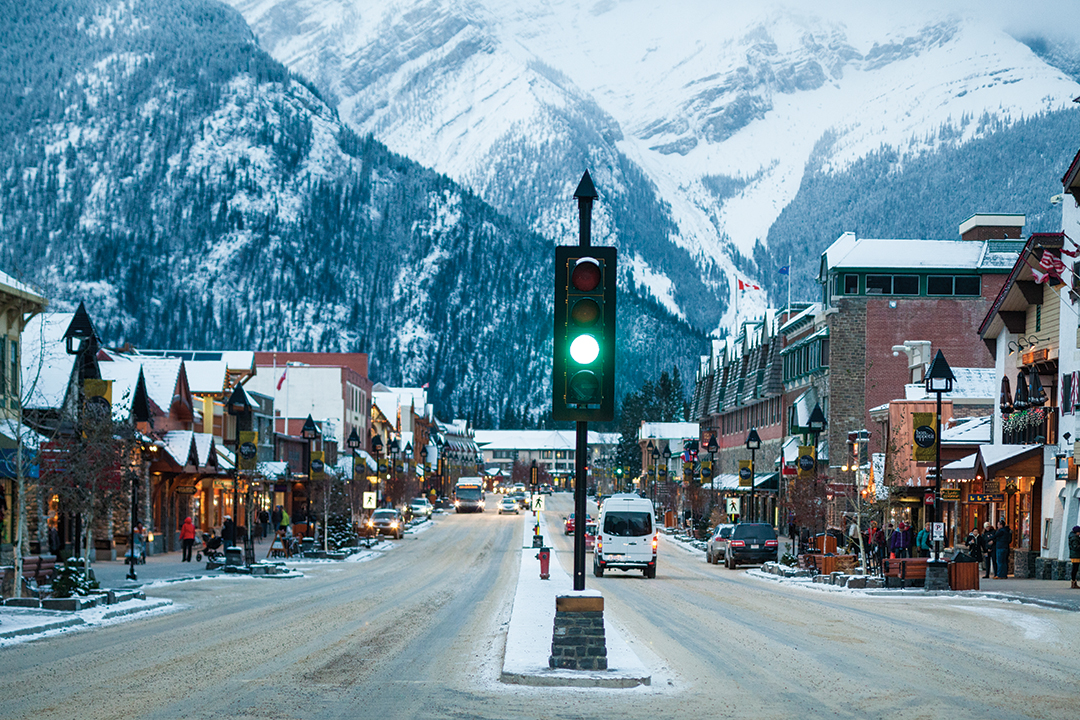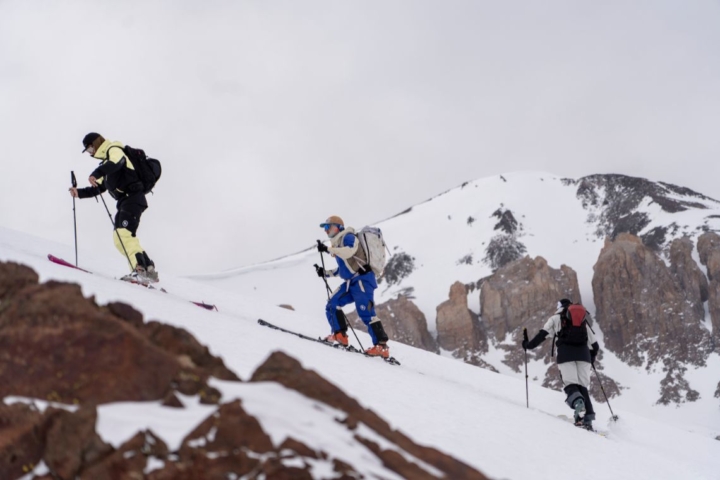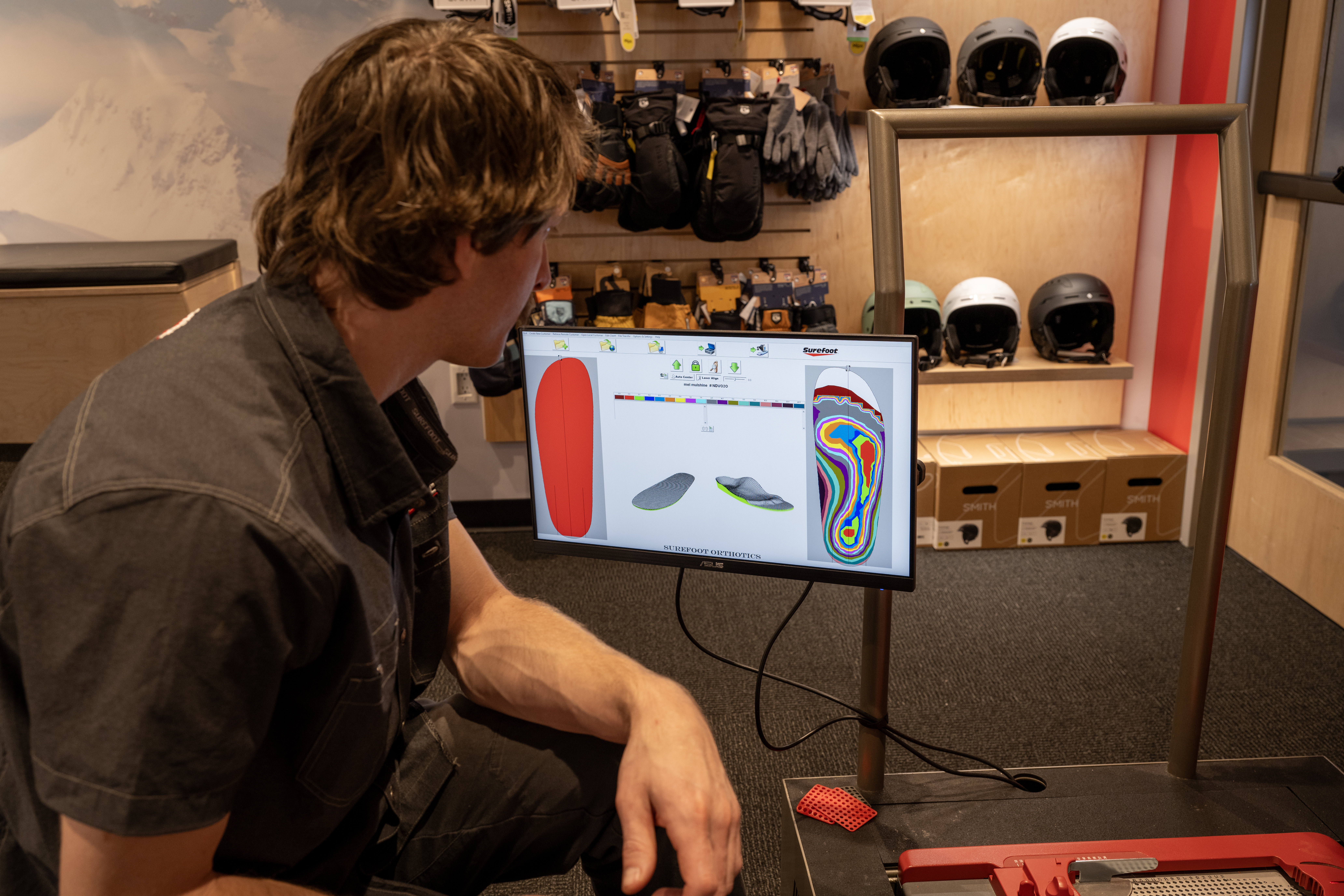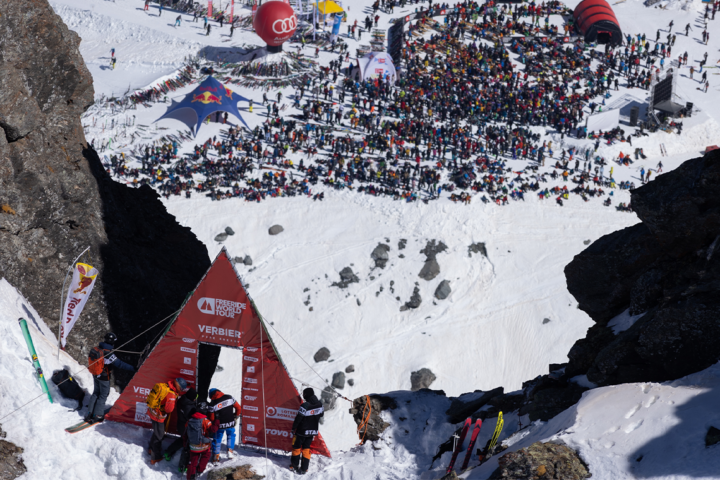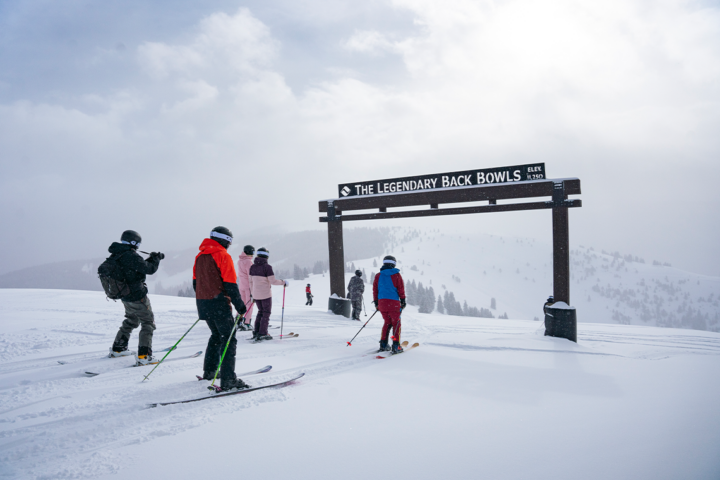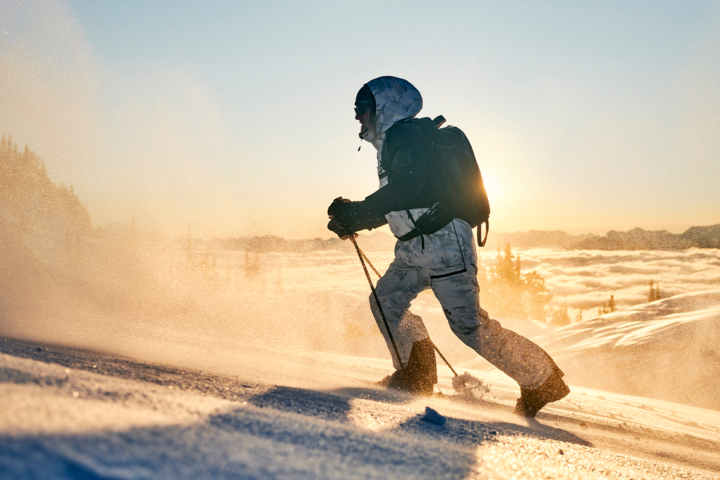Alberta doesn’t always get the recognition it deserves—a surprising notion given what lies within its borders. Tucked away in the southwest corner of the Canadian province is Banff National Park and the town of Banff itself. The park holds claim to one of the most astounding natural settings you’ll ever come across and the town, rivaling its neighbors to the west, is one that can accommodate skiers of any type, budget or personality. It’s a no-bullshit destination where residents will welcome you with open arms, leaving you wondering why you haven’t made it there before and when you might be coming back.
Photos: Ryan Creary
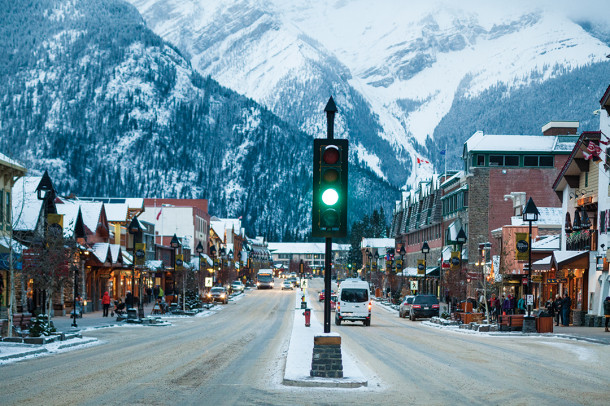
The closest major city to Banff is Calgary, about 80 miles to the east, in South Central Alberta. From there, you can hop on a bus or rent a car for the 90-minute drive that winds from the plains into the Canadian Rockies before you find yourself in the shadow of Cascade Mountain, a rocky pyramid that looms over Banff at a height of almost 10,000 feet and provides the quintessential mountain town view for residents and visitors alike.
Banff Avenue is the main drag, and as my friend Reily and I pulled into town last January, we found our accommodations, the Fox Hotel and Suites, right there among many other options that range from mediocre to magnificent. A very nice young lady with a thick Australian accent got us checked in. While it seems that many American skiers have yet to discover Banff, we quickly came to find that the Aussies have been in the know for a while.
Most of the bars and restaurants in Banff lie within a few blocks of each other. We headed downtown our first night and bellied up to the bar at the Elk and Oarsman, a second-floor pub on the main drag. As we chowed down some delicious elk burgers, the bartender advised us on some of the spots in town: St. James’ Gate (a.k.a. The Gate) for a good pub scene with live music; the Devil’s Gap, where the younger locals go to get loose once they’re done serving the tourists; and The Dancing Sasquatch or Aurora nightclubs if you’re into the club scene. He also mentioned the Pump and Tap, a British football bar in the basement of a slightly odd indoor mall of sorts, where one could surely find some salty residents and a good time.
We settled up and were just about to head out when the bartender set two shots of Jäger in front of us. Not my first choice in spirits, but the small glasses of syrupy black liquid represented two things: the welcoming nature of the people in this town and that while it may not be listed on any official documents, Jäger is most definitely the official drink around there. The barkeep raised his own glass in a gesture of solidarity, and down the hatch they went.
The trifecta of ski resorts around Banff are known as “Canada’s Big 3,” and a convenient shuttle service runs from various points in town to each of them. We’re not talking run-down school bus shuttles either, but rather plush motor coaches. The closest resort is Mt. Norquay, which boasts a town hill kind of feel and sits just on the other side of the highway, about five minutes outside of city limits. Norquay offers night skiing on Fridays and Saturdays as well as outside-the-box events like Chairlifts of Love, chairlift speed-dating for those who can’t seem to pull themselves away from the hill long enough to have a conversation with somebody of the opposite sex. Don’t worry, we understand the addiction.
Sunshine Village is the second closest resort to Banff, about 25 minutes southwest of town. We hopped a shuttle there for our first taste of the terrain Banff had to offer. A quick gondola ride out of the resort parking lot takes you up to one of two base areas. From there, you can access the three mountains that comprise the ski area.
We headed toward Lookout Mountain, and after a few warm-up laps, made it to the top, and the entrance to Delirium Dive, one of two zones at the resort where you find a steel gate at the entrance (the other is Wild West on Goat’s Eye Mountain). The self-locking entry points are secured by Backcountry Access sensors that only unlock once they detect the ping from your transceiver, which is required along with a shovel and probe.
As we approached the access gate, three confused Frenchmen were pulling on the handle and looking unsure as to why it wouldn’t open. A ski patroller asked them to step aside—apparently we looked like we knew what we were doing. I bellied up to the gate, and the red X changed to a green circle, unlocking the latch. Maybe the Frenchmen were well versed in backcountry safety but not the gate protocol, or maybe they were clueless. Either way, it’s a great system that many ski areas could benefit from.
Although I was psyched to ski, the view of the surrounding peaks from the top of the five-minute hike stopped me in my tracks, compelled me to bring out the iPhone and turned me into a full-on tourist. Looking south from the resort I saw a seemingly endless span of snowy peaks with Mount Assiniboine rising sharply amongst them.
With the panorama shot banked, it was on to surveying the terrain below. While this particular zone is inbounds at the resort, it’s gated for good reason. Proficient route finding and good decision-making skills are critical as the area is littered with rocks and cliffs.
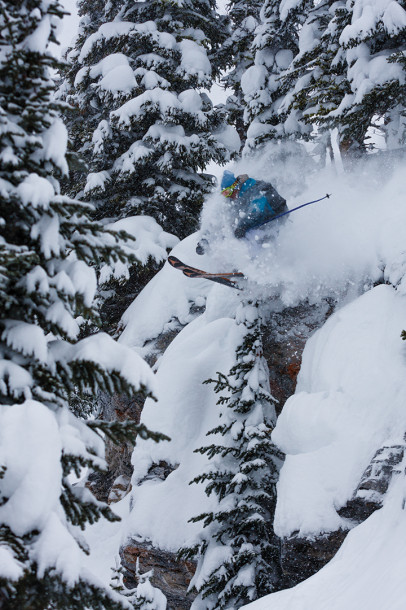
We chatted with a few locals at the top about the different routes we could take and, having studied photos, I started to put the pieces together. We dropped in skier’s left through a rock band on a chalky 50-degree slope. We slashed pow turns through the gut and took a hard right in the direction of some trees. In the woods, we found some untouched pillows just begging to be dropped before we popped out onto a groomer to the base of Goat’s Eye Mountain. Over three thousand vertical of pure bliss. Goat’s Eye holds similar terrain, and we lapped that before heading back for another run in Delirium.
In the parking lot, we found the shuttle back to town and headed down to the Banff Brewing Co. where, over some fine craft beers, we chatted with the Big 3 Resorts’ PR team about our day at Sunshine Village. They also filled us in on Snow Days, an annual event that happened to coincide with our visit. It seems that they could rename it the Ice Festival, based on the activity list: ice carving, ice skating, ice hockey and ice climbing on a 40-foot wall erected on the side of Banff Avenue, to name a few. But hey, the naming thing is their deal, and the lengthy list of activities sounded pretty entertaining nonetheless. The server came by and dropped off a plate of lobster maki rolls and a heart-clogging mound of classic Canadian poutine—two things I really wish I could order at the brewpubs back home in Boulder. We made sure nothing went to waste.
For our second day of skiing, we made the 40-minute trip northwest from Banff to what’s known affectionately as “The Lake.” Looking out from the top of Lake Louise Ski Resort yields an unparalleled view of the jagged Canadian Rockies that pierce the skyline and stretch well into British Columbia. No lift lines and 4,200 acres of skiable terrain made for the closest experience to having our own private mountain for a day.
Skiing on the frontside starts with above-treeline turns that feed into progressively tighter glades below. The backside offers an impressive span of steep shots and wide open bowls with scattered, rocky terrain. A portion of the skiing at the north end is accessible only by a relatively easy hike along the ridgeline, and a wide open and tempting 45-degree couloir at the far end is well worth it. We got in a rhythm, hiking a little further each circuit until we finally hit said couloir, called F Gully. By the time I exited the bottom of it I was pleasantly exhausted. When Reily came hooting and hollering down behind me, we knew that was a good note to end the day on.
After a quick cup o’ noodles in the lodge, we took a short drive across the highway to see the classic view of Lake Louise that, in person, surpasses what you’ll find in any Google search or photo album of those who’ve visited the area. The glacier-fed lake, which sports an aqua green hue when it isn’t blanketed in snow and ice, sits below Mt. Victoria and in front of the impressive Fairmont Château Lake Louise. One look and it’s no wonder why it’s the defining image of the area.
Later that night, we grabbed burgers at the much acclaimed Eddie Burger, and as we strolled down an adjacent alley, we saw an interesting basement bar through a semi-frosted window. We concluded that it was the Pump and Tap that we had heard about and decided to head in for a beer. Our suspicions were confirmed by the bartender’s shirt which read, “F#*K THIS! I’m going to the Pump!” One beer turned into two, then two into four as we chatted with a rowdy bunch of locals who passed out more Jäger shots than I could count. We returned the favor and before we knew it, we were on to the next spot, The Devil’s Gap, where a walk up a flight of stairs took us from a quiet, snowy street corner to a raucous bar scene. By the end of the night I was ringing a giant bell on the bar top and buying everybody shots. Not bad for a Tuesday.
In a town flanked by multiple ski resorts and a postcard-like setting, with great food and good people all around, one could easily surmise that the classic ski town story plays out here quite a bit: Visit or move to town for a season, stay for a few more and then end up a “lifer,” destined to roam the mountains for as long as you can. Though a career in ski bumming isn’t for everybody, ski trips are, and as you start milling over your next destination, you should most definitely throw Banff in the mix.
This article originally appeared in the 2014 Photo Annual issue of Freeskier, Volume 16.5. Freeskier Magazine is also available via the iTunes newsstand.
